2023: Reflected, your Polar Year in Review for 2023
As the year draws to a close, it’s time for reflection, a moment to sift through the pages of the past twelve months. Yes, here it is: 2023: Reflected, your Polar Year in Review for 2023. We dug deep into the stats from around the globe to see how different workouts in different countries and age groups measured up. Plus, we looked at how Polar users rested each night, which made for some surprising sleep results.
Here, you’ll find some fun facts about the top four ways Polar users loved to get active in 2023: running, walking, strength training, and cycling. Plus, some data on hiking and swimming is also thrown in the mix. Of course, 2023: Reflected is based on anonymized data from millions of Polar users worldwide. These insights are drawn from December 1st last year through November 30th this year to give you the full 12-month view of how we all exercised and slept.
But before we get to that, congratulations on contributing to an average of 294 hours of tracked exercise in 2023. That works out as 5 hours and 39 minutes weekly, which means Polar users understand the importance of a healthy balance between training and rest days. So, let’s look at some of the most interesting nuggets of info to inspire your sleep and exercise in the coming year.
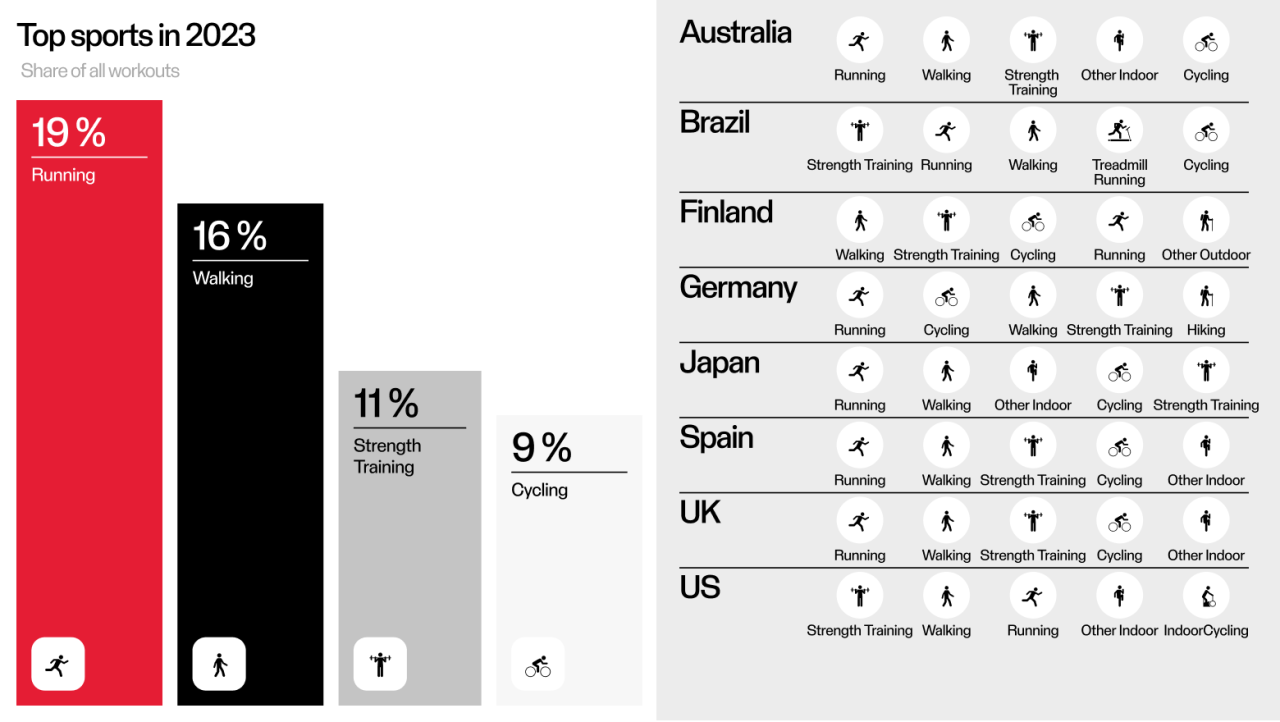
WALKING FOR MORE ACTIVE LIVES
If there’s one type of workout we’ve seen rise and rise since 2020, it’s walking. Yes, partly because it was a popular way to get outdoors during the pandemic, but in turn, we’ve become increasingly aware of the benefits of this low-impact exercise that often takes us into nature.
That means we’re probably starting to take our walking just as seriously as other forms of core training. You may be using it as a way to get around and hit your 100% Daily Activity every day. Or simply remembering to track this exercise with your Polar walking sports profile when heading out for a stroll of 10 minutes or more. All of this adds up to better fitness for you and the continued popularity of walking during 2023.
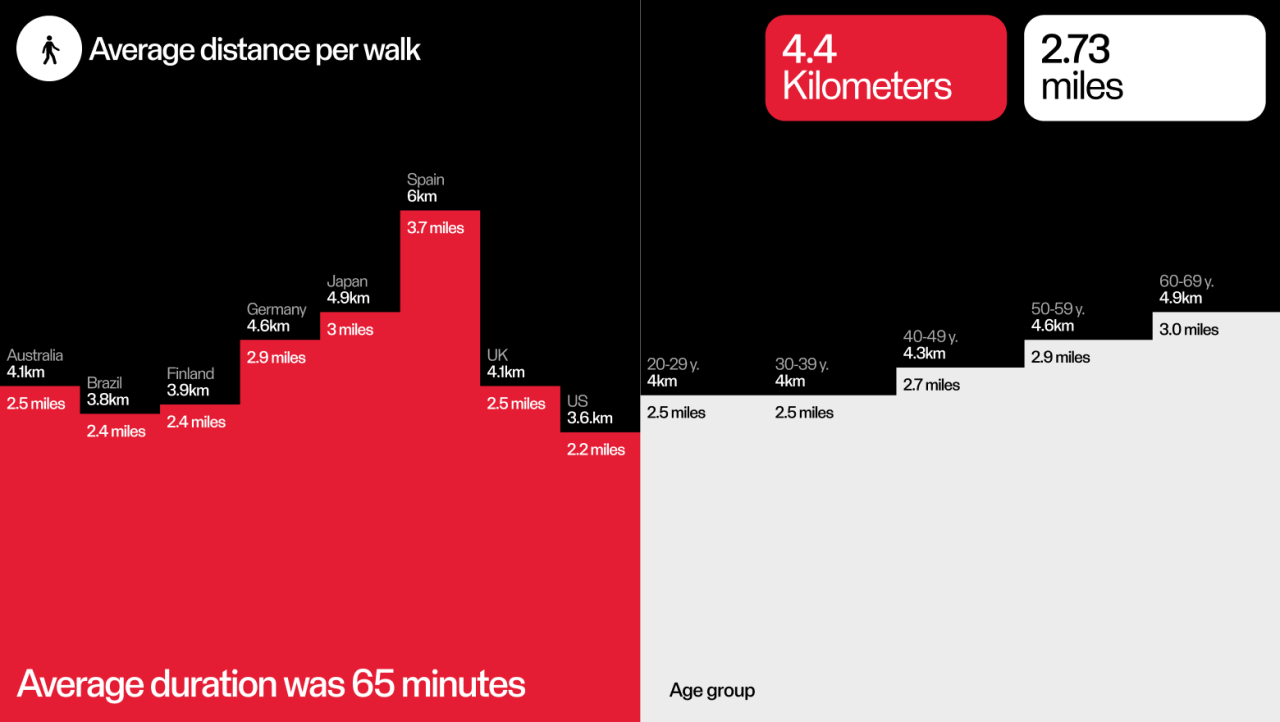
It was the second most tracked workout globally, making up nearly 16% of all tracked workouts by Polar users. Across all key regions, walking ranked in the top three workouts, coming second only to running in widespread popularity. Spain was its biggest fan, clocking in at an average distance of 3.7 miles (6km), while the USA was the lowest, with a typical distance of 2.2 miles (3.6km).
Want to up the ante on your walking next year? Picking up your pace can lift the intensity and effectiveness, turning your walk into a cardio workout. You can also try some run/walk intervals if you’re curious to try running. Alternatively, adding an ascent can turn your stroll into a hike.
EMBRACING THE GREAT OUTDOORS
Hiking was the eighth most popular workout tracked by Polar users in 2023, with those in Japan achieving some pretty impressive numbers. Whether climbing to the summit of Mount Yari or taking in the beauty of the Kumano Kodō trail, hikers in Japan averaged an ascent of 613m – more than double the global average. They also clocked in an average distance of 5.5 miles (8.8km), making them the all-round hiking heroes this year.
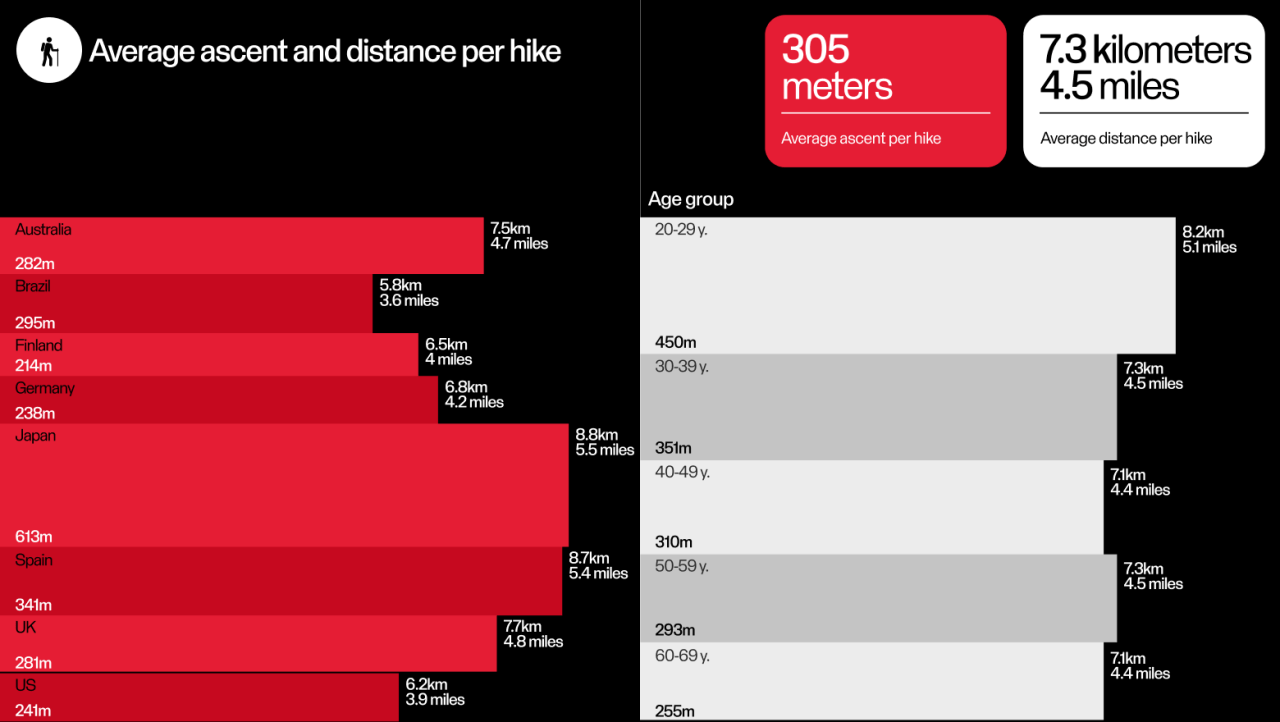
Globally, those who were similarly keen on hiking were people in their 20s. This age group averaged an ascent of 450m, which was 100m higher than those in their 30s (as the average ascent diminished in accordance with age). Those in their 20s also pushed themselves to typically hike 5.1 miles (8.2km), making them almost on par with the efforts of people in Japan. Ah, to be young and adventurous with supple knee joints, eh?
RUNNING UP THAT HILL IN 2023
What was the most popular workout this year? Why running, of course. It made up 19.22% of all tracked workouts by Polar users in 2023, topping the charts in Germany, Japan, Spain, Australia, and the UK. It makes you wonder how many of those runs contributed this year to the one billion streams on Spotify of that Kate Bush track.
So, how far did everyone go? On average, tracked runners did 4.84 miles (7.8km), roughly the same as running across Manhattan from the Brooklyn Bridge to the middle of Central Park. People from Germany drove up this average by typically doing 5 miles (8.1km), followed closely by runners in Japan who did 4.9 miles (7.9km). Australia and the US had the shortest average distance per run, clocking in at 4.1 (6.6km) and 4.2 miles (6.7km), respectively.
AVERAGE MARATHON TIME
For those who really went the distance in 2023, there was an average marathon time of 4 hours and 10 minutes. It’s impressive when you think about the broad range of Polar runners across the globe. To those who ran their first marathon this year – no matter what your time – we salute you. Very experienced Polar runners aiming for the (in)famous sub-3-hour marathon time in 2024 might appreciate these few things to consider when setting goals for the new year. And if you find yourself needing an epic running playlist for your next marathon, here’s one with 200+ tracks to keep your legs moving.
SLEEPING THROUGH THE YEARS
Tracking your sleep can reveal some genuinely fascinating data. You’ll likely discover interesting insights about what is happening with your body while snoozing, like how much REM sleep you’re getting vs. deep sleep. Perhaps you’ve noticed how alcohol affects your nightly slumber (hello, upcoming festive season, we’re looking at you) or how experiencing different types of stress can impact your sleep – including the physical stress of a high-intensity workout.
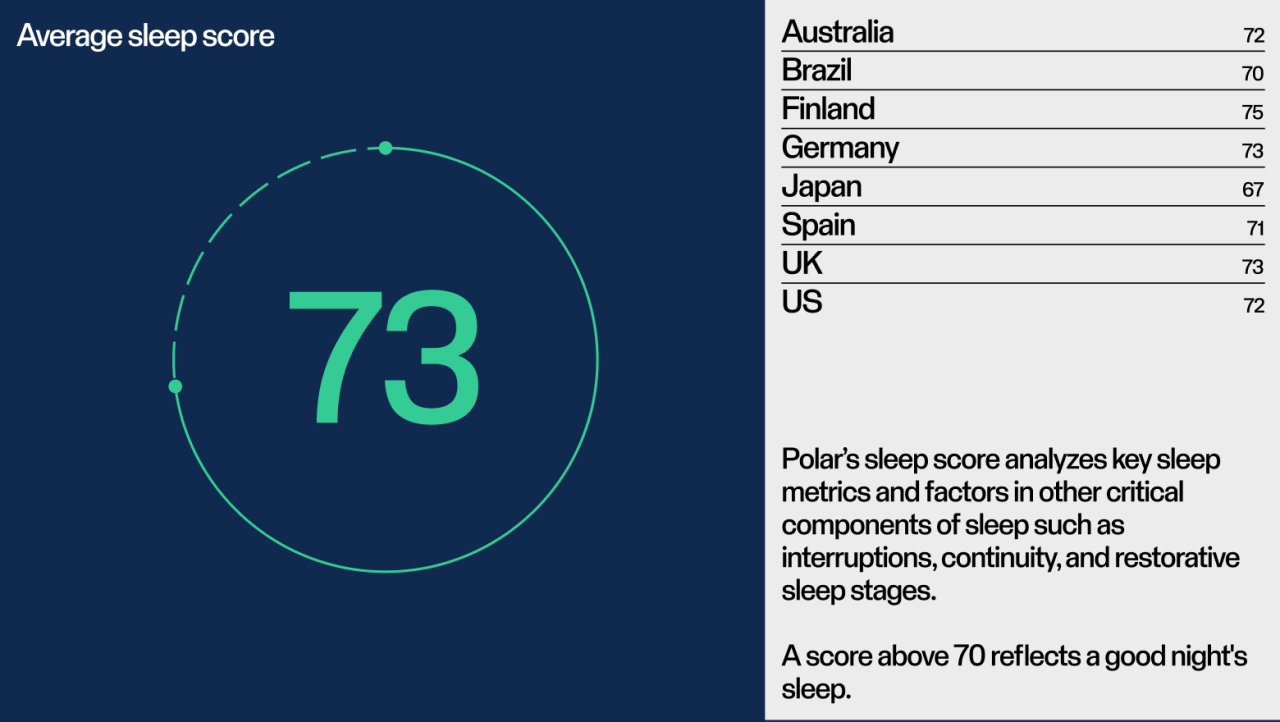
Have you ever wondered how your sleep score on Polar Sleep Plus Stages™ compares with everyone else? Across the globe, the average sleep score for 2023 was 73, and the typical sleep duration was 7 hours and 29 minutes. That meant, on average, we fell asleep at 11:32pm and woke at 7:02am. Let’s look at how this differed between some countries.
Down in Australia, they appear to have a great sleep hygiene approach. They typically were the earliest to bed, drifting off on average at 10:51 in the evening. However, that did mean they were also likely to wake earlier, typically bouncing out of bed around 6:26am. It must have something to do with all that sunshine and great coffee (plus the impressive dawn chorus of birds that start signing as soon as day breaks, Yes, even in the cities).
In Japan, they woke up even earlier, on average around 6:18am, which would leave most of us needing a very strong cup of sencha fukamushi tea to handle rising at this time. Especially when you see that, on average, people in Japan fell asleep at 11:37pm. That gave them the lowest snooze duration for 2023, with an average of 6 hours and 41 minutes. It clocks in just shy of the recommended 7-9 hours of sleep each night for adults, which explains their considerably lower sleep score average of 67.
Over in Europe, some traditions remain hard to break, with people in Spain getting to bed at 12:14am. Culturally, that fits with the late time of their evening meal, so at least they’re probably not still digesting dinner when starting to sleep. They typically snoozed through until 7:30 in the morning, so their average sleep duration (7 hours and 16 minutes) and sleep score (71) were still alright.
Another sleep stat of interest was the differing sleep duration between age groups. You may assume that people in their 30s would have perhaps the lowest amount of sleep, especially if they were new parents or working longer hours with an increasingly demanding career. Surprisingly, though, people in this age bracket slept most throughout 2023, averaging just shy of eight hours at night. Looks like millennials really know the importance of a great night’s sleep.
It tracks that sleep declines in average duration as age increases because how you snooze changes in later life. People in their 60s had an average of 7 hours and 30 minutes of sleep during 2023, which is still a significant amount of rest. However, this result is likely influenced by the fact that we get less slow-wave deep sleep after 65. Hence, you’ll probably be an early riser when you reach this age.
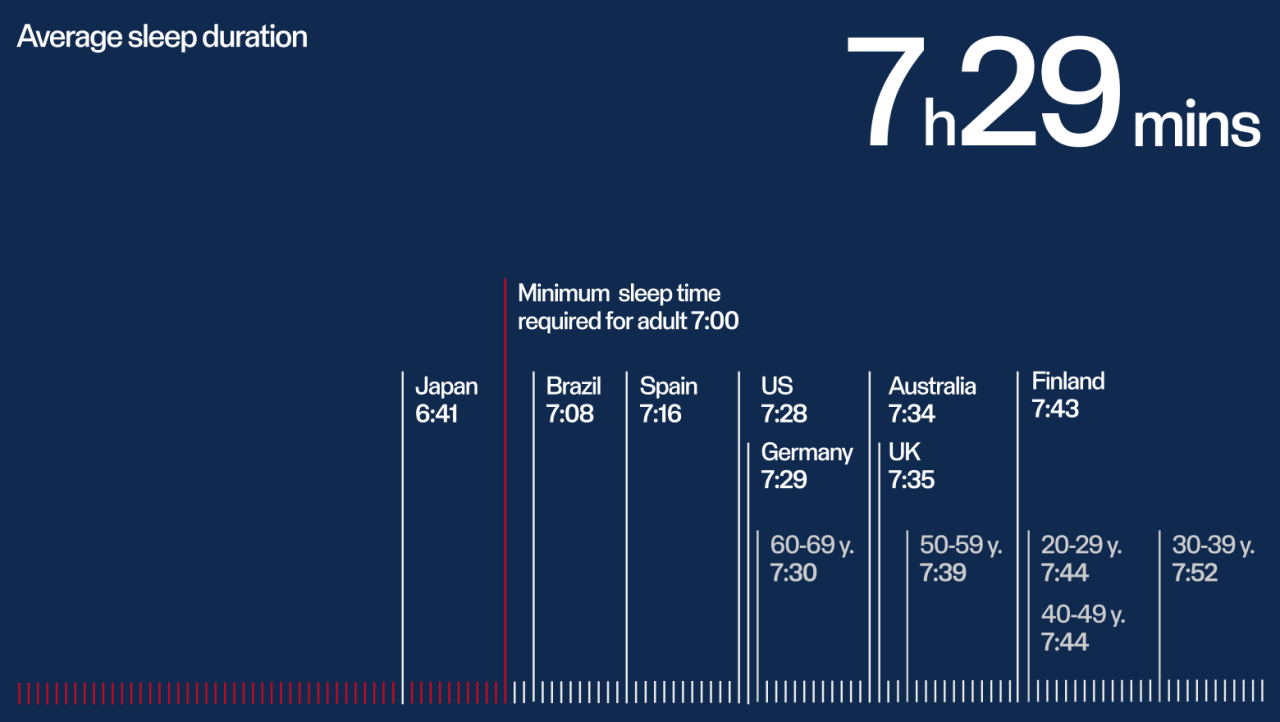
50S AND 60S STORM THE STATS
The early birds are clearly catching the worm, though, as Polar users aged 50+ shone through with impressive results in 2023. One of the standout ones is the average duration of a strength training session. Those in their 60s matched those in their 20s by typically having the longest training time of 67 minutes. That’s over an hour of squats, bicep curls, and deadlifts, which means some of you are heading into 2024 with toned muscles to show off.
Unsurprisingly, strength training is a priority for this age group. After thirty, we all slowly lose muscle mass, strength, and function – around 3-5% with every decade. The best way to counteract this: strength training. No matter how you do, building muscle as you age should be a priority in your workout plan.
Another impressive stat for these age groups was the amount of time they spent working out. Those in the 50s came in second with an average of 6 hours and 7 minutes of training each week, which sounds like an hour a day plus a rest day, which we applaud. They were only beaten by those in their 60s, who typically did 7 hours and 5 minutes of working out each week. That’s at least two hours more than the average person in their 30s (who clocked around 4 hours and 56 minutes a week).
Runners in their 50s showed they could go the distance in 2023, with the longest average distance. Surpassing all over, they typically ran 5.1 miles (8.2km), which is excellent news for their cardiovascular health and overall fitness. As for those in their 60s, it was walking where they shone through, with an average distance of 3 miles (4.9km) per session. This result isn’t surprising as making walking a daily habit is a crucial way to stay fit over 50, as it places less stress on your joints and can help lower rising levels of chronic stress that affect us in our later years.
FUN FACTS AROUND THE GLOBE
A funny coincidence is that users in Brazil, Australia, Japan, and the UK all typically did 7 hours and 7 minutes of exercise each week. Some impressive synchronicity there. Those in Finland, Germany, and the US all clocked an average of 5 and a bit hours each week – but perhaps they were working out smarter or harder rather than longer?
Cycling made it into the top five types of exercise in all key countries, with the average rider doing 12.27 miles (19.7km) every time they jumped on two wheels. But there was a considerable variation in the typical distance between countries. People in Spain averaged an astonishing 20.5 miles (32.9km), followed by cyclists in Brazil who rode 16.7 miles (26.8km). Perhaps there’s a correlation between better weather and longer cycling distances because our very own Finland was at the other end of the spectrum, with an average of 7.1 miles (11.5km).
People in Finland were also not too fond of a long swim session, with an average distance of 1,558m, followed by those in the UK with 1,669m. However, some swimmers in Australia were clearly training for the championships by typically doing 2,847m per session. If an Olympic pool is 50m long, they do almost 57 laps every time they go for a swim. As they say Down Under, crikey!
SEE YOUR STATS
Well, there you have it: 2023 reflected through the Polar experience. Here are a few other fun stats of note for this year: Tuesdays were the most popular workout day, August 15 was the most active day, and April 16 was the day with the most runs. Not surprisingly, those dates line up with key moments in the Northern Hemisphere (mid-summer and mid-spring, respectively), so we’re clearly influenced by good weather.
So, how did your 2023 compare? Simply log onto Polar Flow and you can see how you rested and worked out throughout the year in comparison. In the Polar Flow app, you can see a snapshot of your activity each month and sleep each month. Or jump onto the reports section of Polar Flow’s website to see deeper insights into your training and running index, plus a six-month view of your sleep and cardio.
Take a look and share with us on Instagram your most surprising stats of the year this year. Did you run further than most people in your country? Or sleep about the same as people in Japan? Either way, take these insights into the new year and let your data provide some extra inspiration for 2024.
Just remember: see your new year as a marathon rather than a sprint. Don’t try to do too much too soon, as you won’t be able to sustain that (and will probably give up). Instead, think steady and consistent, and you’ll be off to a great start. Good luck and we wish you a happy, healthy and restful start to 2024.
Check out the Polar RIA Foundation Member profile here .
